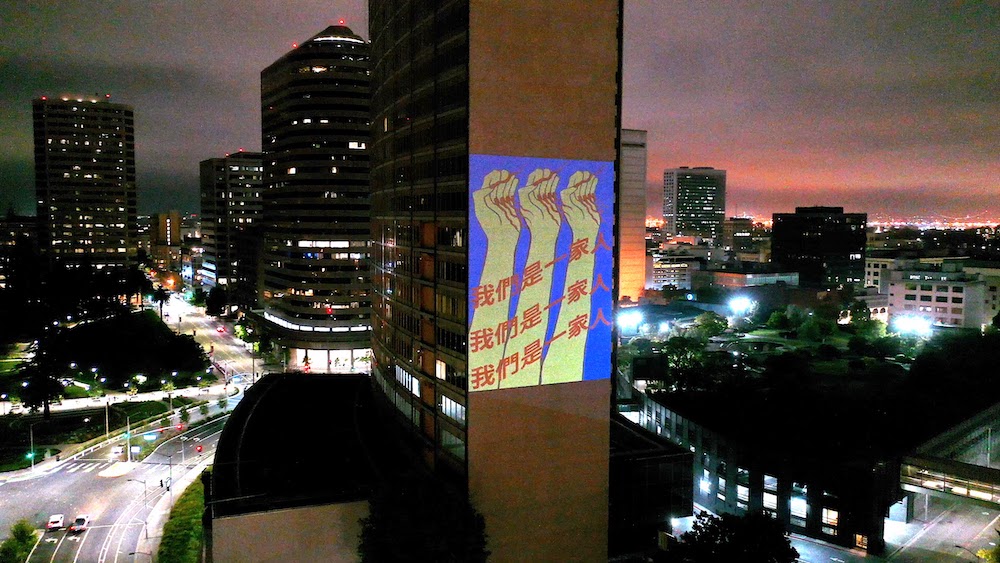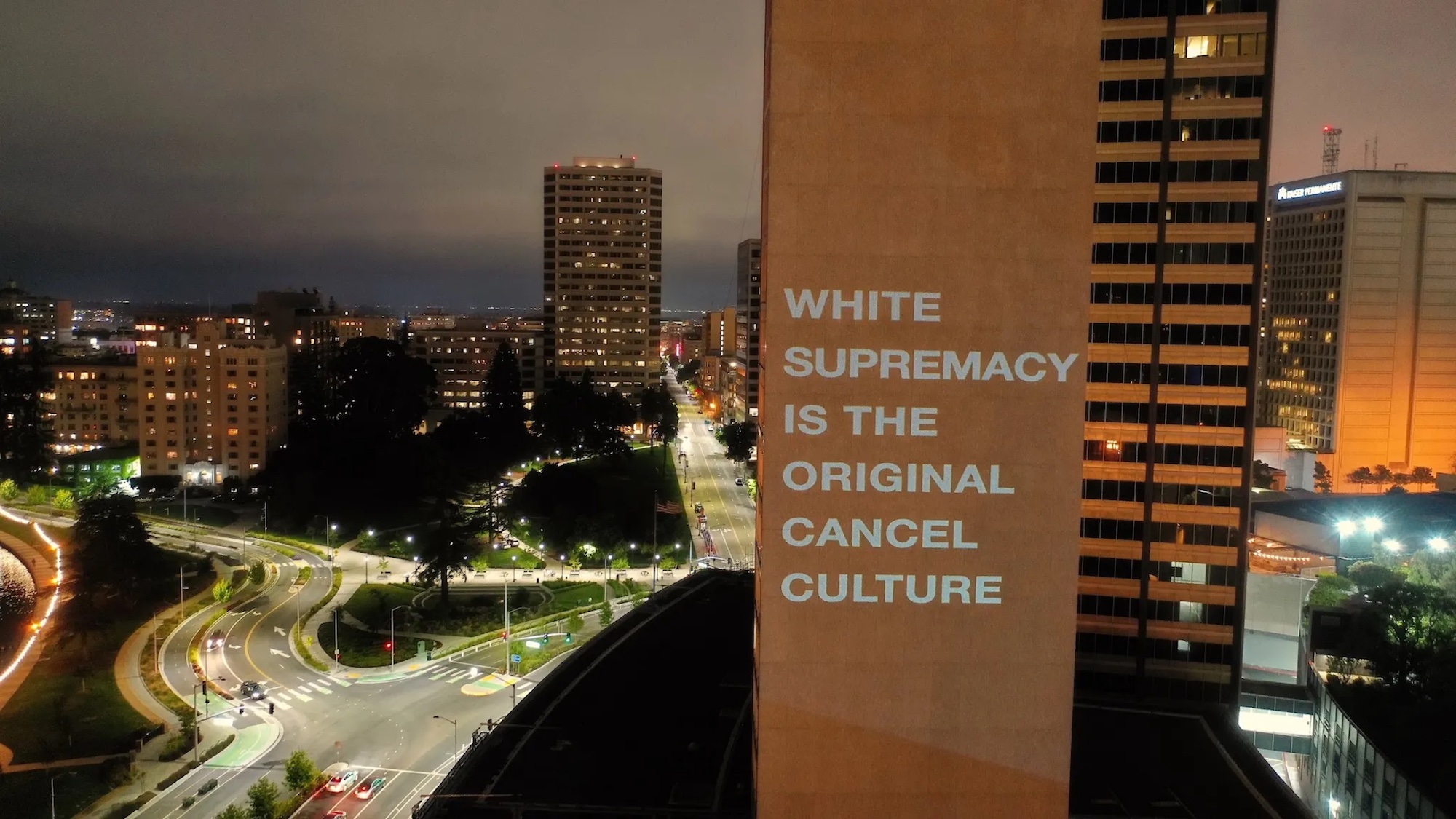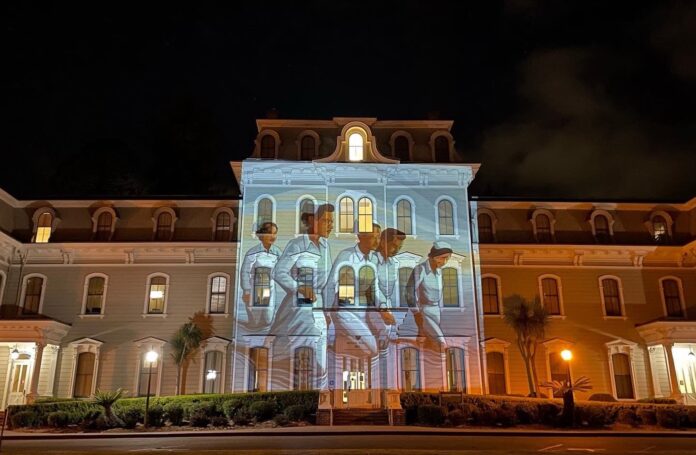Filmmaker and interdisciplinary artist Christy Chan started “Dear America” after a 21-year-old white man went to three massage parlors in Georgia in March and murdered eight people, including six Asian American women. Chan wanted to respond quickly, skipping the usual fundraising she does for projects. She felt it was important to take up large amounts of space, and worked with other Asian American artists to project images with anti-racism messages in eight Asian languages as well as English on high rise buildings around the Bay Area.
With artworks by people including Cathy Lu, Jenifer K. Wofford, and Christine Wong Yap, “Dear America” has projected images with messages such as “Dear America, Fix Your Racism,” “White Supremacy is the Original Cancel Culture,” and “Asian America is America” onto buildings in downtown San Jose and Oakland and San Francisco’s Grace Cathedral. Chan said everything was donated, including cords, tripods, and umbrellas to block wind, and volunteers showed up to watch out for the artists’ safety.
The final event will be August 12 at the Montalvo Arts Center in Saratoga, and rather than a guerilla installation, the leadership worked with Chan to make it happen. They’re interested in addressing the history of the center, which is in former villa of James Duval Phelan, a San Francisco mayor and US Senator. Along with supporting the arts, Phelan also backed anti-immigrant policies, including the Chinese Exclusion Act of 1882, and he wrote an essay, The Japanese Evil in California.
On a phone call with 48 Hills, Chan talked about taking up space and combatting the false narrative that Asian Americans need permission to be here, making art to combat white supremacy, and shifting the story.

48HILLS Why did you want to do projections?
CHRISTY CHAN I work in media arts. I’m a filmmaker, and I have almost 20 years of experience working in film production. My art is driven by storytelling, and I really care about narrative equity. With film, it’s a way to tell a story that’s very visible. I’m drawn to cinematic storytelling, and there’s something symbolic about projecting light in the dark.
48H I’ve read that you say you wanted to take up space with this project. Why is that important?
CC I started the project right after the Atlanta shootings. I’ve been working in art that questions white supremacy in general, not just against Asian Americans, and I started organizing and conceiving the project five days after the Atlanta shootings.
Typically, I spend one to five years on fundraising, but for this, I didn’t want to go through traditional arts channels. The way I think of it is white supremacy doesn’t operate on a grants cycle, and sometimes neither can I. I didn’t think it made sense to go through my typical process of fundraising for eight months. I choose guerilla productions because I wanted to respond quickly and to me this project is about the right to take up space.
Anti-Asian racism is not new, but for the last few years, politicians have been weaponizing these stereotypes. Asian Americans have been in this country since the 1800s in large numbers, and Filipino Americans were here in the 1600s, but there’s always been this false narrative that Asian Americans need some kind of special permission to be here, that our belonging has to be granted by non-Asians. So for me this project is about unapologetically taking up a lot of space and doing it in a way that’s raw and unfiltered and celebrating each other’s presence. I think to just show up and project is in the spirit of the project.
From my point of view, I don’t think guerrilla installations of messages are that radical compared to the day-to-day experience of just walking around as a person of color if you’re in a homogenous or racially unfriendly space. Depending on where I am or where my family and friends who identify as non-white are, your body itself is an installation. Wherever you show up, you are a guerilla installation. So for me projecting these artworks 15 stories high as guerilla, it felt very much in keeping with the spirit of the messages of solidarity and resilience, and my goal as the project organizer is to show authentic points of view.

48H Many of these installations are done without permission, but your final event at Montalvo Arts Center is done in coordination with the leadership there. How did that happen?
CC They have an artist’s residency program, and I was an artist-in-residence in 2013. I consider them an organization who’s interested in looking at their history and coming to terms with it and not just in the last few years. I approached Montalvo because I thought this could be a great culminated event. I didn’t know about the Phelan history while I was there. He campaigned with a racist slogan, keep California white. He was part of spearheading the movement to restrict Chinese immigration to the United States, and he played a big role of keeping Chinese Americans out and creating the sentiment that Chinese Americans here did not belong. He also recommended the relocation of Japanese Americans.
For me as an artist at Montalvo, I was never treated as an Asian American artist, but rather as an artist whose work they wanted to support. So I felt it could be a powerful act of celebrating Asian American voices and of decolonization We’re going to project Asian American artwork large scale across the historic villa that used to be his home. I think the act speaks for itself. Again, it’s about claiming space. Ultimately, I believe things will change and do change and us being at Montalvo projecting these images shows there’s a change. His narrative was keep California white, and his time is up. Their story comes to an end, and the people that are here now – we get to change the story. We get to shift the narrative.
We get to go to Montalvo with our equipment and our community and all the people standing on the street and project Asian language and anti-racist and Asian American solidarity messages on this villa. It just feels like the right thing to do.
I think one of the effects of white supremacy and violence is it makes a person feel powerless and the reason I make art is I believe making art is powerful, especially public art because it communicates whose stories matter.
With the partnership with Montalvo, it’s part of the shifting of the story. I am simply wanting to say to Asian Americans, you are visible, your stories matter. I think this night is important to not only make the statement that stories change, but to celebrate all the people who are part of this project.
DEAR AMERICA will be at the Montalvo Arts Center (15400 Montalvo Road, Saratoga) on Thursday, August 12, 7:30–9:30pm. More info here.




